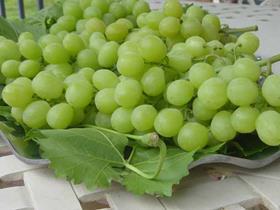
The first official South African table grape export crop figures for the 2011/12 season has been released, indicating that the total export volume will rise again this year after a disappointing prior campaign.
The South African Table Grape Industry (SATI) says that the total export crop could reach 52m cartons if conditions remain favourable. As is customary, SATI has issued a forecast showing a worst and best case scenario, with the crop expected to vary between 50m and 52.1m cartons.
The Orange River region is expected to deliver the biggest increase of all the South African growing regions when compared with last year, with its crop rising from 13.9m cartons to around 16m cartons.
SATI says harvesting in the Northern Province and Orange River Region will start up to two weeks later than last year, with the first grapes being packed in week 45 and week 46 respectively. The Olifants River is expected to start in Week 48, while the Berg River will commence harvesting around week 50. The Hex River Valley is expected to start around week 52.
'Cold evening temperatures are the main reason for the delay in the Northern Province, but this will not have any impact on production,' SATI reports. 'Early Sweet and Prime will be the first varieties to be harvested. These harvest weeks are subject to weather conditions remaining favourable.'
With the season virtually at hand, growers are nervously watching developments in Europe where the latest eurozone problems are expected to make things difficult. They will, however, start the season with a much more favourable exchange rate then has been the case for the last two years.
Meanwhile, SATI says it will be embarking on a new project in the UK this season to promote the products of emerging farmers.
'Consumers will have the opportunity to learn more about ethical trade and have access to stories on emerging table grape producers who now have the opportunity to export their grapes to this market. It is also SATI's intention to roll out this project to other markets.'
In order to do so, QR codes – a two dimensional bar code that can contain any alphanumeric text and often features URLs that direct users to websites where they can learn about an object or a place – will be used to spread SATI’s transformation story.
Asian markets
In addition, SATI has also briefed growers on progress with regards to better market access, mainly involving markets in the East.
South African grape growers are still yet to regain access to Thailand, which has been a lucrative market in the past but was lost some years ago through administrative bungling. 'A trade concern has been raised and is in the process of going to the World Trade Organisation (WTO) in order to regain access,' the SATI statement reads.
In Vietnam, the industry is monitoring the current revision of the act, but SATI says it is still open for South African grapes. 'However Vietnam is in the process of reviewing all their access requirements. The Industry is keeping a close eye on this and ensuring that we don’t miss any deadlines.'
SATI has also urged growers to make sure they comply with entry requirements in Malaysia and Indonesia
South African grapes have not yet been granted entry into Cambodia or South Korea, while pest risk analyses are pending in Mexico, Kazakhstan and Australia.
Further afield, in Iran, SATI is working closely with the South African Department of International Relations to deal with the problem of fluctuating tariffs, while in Russia it has engaged a local agency to provide weekly information as well as a rapid alert watch to any potential access issue that may arise.
While access has been gained to Japan, this only applies for Barlinka grapes. SATI says Japan is a special steri market and registration is required. The same applies to China, while in India, South Africa is seeking more favourable tariff access.



